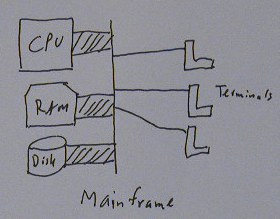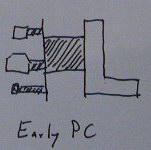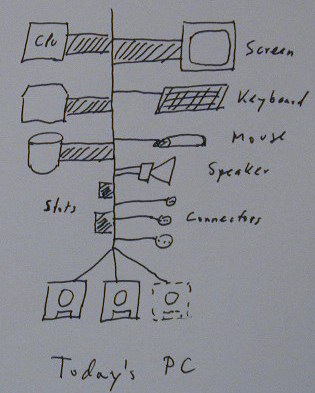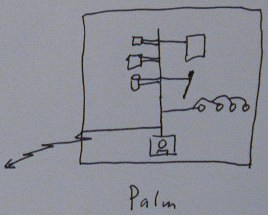danbricklin.com/speeches/wlforum2000
|
|
|
|
Draft #1a (cont.)
|
Now let's compare it to an early personal computer.
  Tiny CPU and RAM. Even tinier disk. In fact, the storage was often a cassette tape recorder. People would look at it and laugh. How could this be a computer? You could barely do payroll for one person. But let's look more closely.
  Unlike the low speed connection between the mainframe and its terminals, the PC screen was directly connected to the memory used by the CPU. This was less expensive to manufacture. This tight, high speed connection to the screen meant you could update it almost instantly. You could do animation, you could scroll around. It was perfect for highly interactive applications with simple calculations. For such applications a personal computer was actually much better than a mainframe. This configuration made possible applications like the spreadsheet and word processing.
The personal computer has been a very fertile device for innovation. It was designed to have new components or software just plugged in or old ones changed. Almost nothing is fixed. It's a tinker's dream. The operating systems were designed to support changing software and hardware. There were places to plug in all sorts of devices.
 As it evolved, many applications could be deployed on it that changed the world, as happened when the spreadsheet brought sophisticated financial scenario planning to individuals, and when desktop publishing and simple databases brought the communications and organizing capabilities once available only to large, rich organizations to smaller, poorer ones.
But, computing can come in other configurations. Other common digital devices are handhelds like the Palm Pilot, game machines like Nintendo, and digital cell phones. In all cases, there are different configurations of components.
 The Palm has a small CPU, a little memory, a small screen, and a combination of pen and buttons for input. It may seem like a joke compared to a PC, but that combination let it fit in a shirt pocket, run for weeks on batteries, and cost just a couple hundred dollars. It made up for its lack of keyboard and printer by being able to be connected to a personal computer to provide those things. Being able to be temporarily tightly connected elsewhere was good enough to provide what it needed. It is much better for sporadic personal use and carrying around than a PC.
Now, let's tie this all together. We have the Internet with all sorts of various digital devices connected through it. We have personal computers, we have big computers we call servers providing extra storage and databases, we have wireless devices, we have handheld devices, wearable devices, we have devices built into vehicles, we have data feeding in from cameras and satellites, you name it.
New applications are easily distributed if they are just software and can run on existing hardware -- the Internet itself can be used to do the distribution. The barriers to creating new applications are quite low. Individuals or small groups can have enormous effect, as we've seen with Tim Berners-Lee's creations that led to the World Wide Web, or with RealNetworks with streaming media, and Napster with, what shall we call it?, "sharing". Look what we've done with just the components of a PC, a single keyboard and screen. Think what millions of different connected devices can do. They won't all be keyboards and screens just showing text and pictures.
What do we communicate? We can communicate static data files. This includes email and publishing, like web sites. For example, here are a few web sites created by regular people: This is a web site showing pictures from a wedding. [Go here, scroll down, and then use Back.] This one [Go here and then use Back] is for returning Peace Corps Volunteers from Uzbekistan, complete with history and links to news. And this small business example of beating swords in to plowshares [Go here , then click on "Current Photos" in links above text, scroll down, and then click on "Frequently Asked Questions" in links above text, and then use Back to get back here] is a brochure for a missile silo converted into a vacation home. It's complete with a Frequently Asked Questions section: "Does Russia still have this site as a target. No."
But web sites are just a small piece of what we can do. We can send live, dynamic data -- such as voices and video, we can have GPS units giving the positions of vehicles, manufacturing machines and medical equipment like heart monitors sending out readings to other computers for processing, and more. Popular current examples include Internet-based telephones, web cams for watching traffic, like these [Go here and then use Back] from the Seattle area, and web sites like this [Go here and then use Back] that show airline data that allow you to track flights and get to the airport just in time to pick up friends.
We can use the Internet to control things at a distance, like milling machines, vending machines, motors to move the cameras we are watching or most anything else, locks, valves, and medical equipment. We can connect to services that do computation, data retrieval and eCommerce.
Many of these applications will be very personal and mundane, just like what happened with cell phones, email, and inexpensive video. They will be part of life, part of interpersonal relationships, not just commerce. When you pick up a cell phone, you aren't like a commercial radio station. You don't say: [speak in deep, announcer-like voice] "This is Dan's Cellular! Two Million Microwatts of Power..." No, you say: "Honey, I'm running late. Should I meet you at Joe's?" Checking if you left the gas stove on at home is important. Turning it off is even more...
So, I hope you see how the Internet is more than just the web, how fertile the combination of digital devices and the Internet is for innovation, and how that innovation can come about even by individuals without government consent.
We hear people talking about future applications connecting refrigerators and clothes to the Internet and laugh. But remember how we used to ask what personal computers would be used for. The early answers were "watering the lawn" and "balancing your checkbook". A $5,000 PC to balance a checkbook? How silly. Well, microprocessors have become so cheap they've been used in irrigation equipment for years, and Quicken has become a major personal use of PCs. The spreadsheet and its effect on finance wasn't even envisioned. Well, look at what Georgia Tech has developed for hooking up sensors to the body: [Go here and then use Back] the Wearable Motherboard, clothing that can connect you to the Internet. The future is coming to us very fast. Thank you. And, of course, you can find a copy of this speech on my web site, danbricklin.com.
|
|
|
© Copyright 2000 by Daniel Bricklin
All Rights Reserved.
|